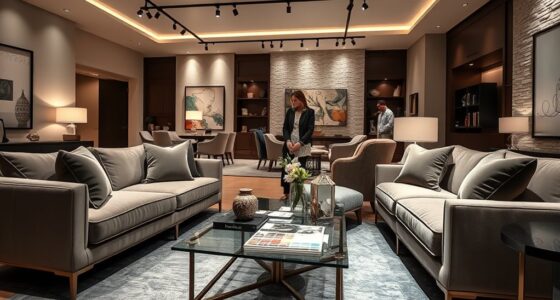Working with architects and interior designers involves understanding their distinct roles. Architects focus on creating safe, functional structures, handling plans and building codes, while interior designers concentrate on aesthetics, color schemes, and furnishings to enhance your space. Collaborating from the start guarantees your project is both well-built and beautiful. If you want to learn how their teamwork can lead to a cohesive, efficient design, keep exploring how they work together.
Key Takeaways
- Architects focus on structural safety, building codes, and initial design, while interior designers prioritize aesthetics, color schemes, and interior details.
- Collaboration from the start ensures cohesive design, with architects handling plans and interior designers refining interior elements.
- Architects ensure compliance with safety and zoning laws; interior designers select fixtures and decor within those constraints.
- Clear role delineation streamlines project management, preventing conflicts and costly revisions during construction.
- The combined efforts of both professionals deliver a safe, functional, and aesthetically pleasing final space tailored to client needs.

Understanding the roles of architects and interior designers is essential when planning a space, as their responsibilities often overlap but serve distinct purposes. When you’re commencing on a project, knowing who handles what can streamline the process and guarantee your vision comes to life effectively. Architects primarily focus on the structural aspects of a building, making sure your space is safe, functional, and compliant with building codes. They handle everything from the initial design concepts to drafting detailed plans that include foundation, framing, and overall layout. Their expertise ensures that your project adheres to local regulations, zoning laws, and safety standards, which is crucial for obtaining permits and avoiding legal issues.
Architects ensure structural safety and compliance from design to detailed plans.
Interior designers, on the other hand, concentrate on the aesthetics and functionality of the inside environment. They select color schemes, furniture, lighting, and decorative elements that reflect your style and meet your needs. While architects create the skeleton of the building, interior designers bring personality and comfort to the space, making it inviting and tailored to your lifestyle. Both professionals often engage in design collaboration, working together to guarantee their visions align seamlessly. For instance, an interior designer might suggest modifications that improve space flow or lighting, but such changes must be feasible within the structural parameters set by the architect.
Building codes play a crucial role in this collaboration. As you move from concept to construction, the architect assures that every design element complies with these codes, which cover everything from fire safety to accessibility standards. This legal framework protects you and future occupants, making sure the building is safe and functional. Interior designers, meanwhile, must also consider these regulations, especially when selecting fixtures or layouts that could impact safety or accessibility. Effectively working within these guidelines requires clear communication and mutual understanding, emphasizing the importance of early and ongoing design collaboration.
Your project benefits when architects and interior designers work together from the outset. They can resolve potential conflicts early, optimize space utilization, and create a cohesive environment that balances structural integrity with aesthetic appeal. This partnership not only saves time and money but also helps you avoid costly revisions later. Understanding the distinct yet complementary roles of these professionals helps you make informed decisions, guaranteeing your project progresses smoothly from initial idea to finished space. Additionally, having knowledge of building codes and regulations can facilitate smoother coordination and compliance throughout the process. Ultimately, their combined expertise results in a safe, beautiful, and functional environment tailored perfectly to your needs.
Frequently Asked Questions
Can Architects Also Handle Interior Design Projects?
Yes, architects can handle interior design projects, especially when it involves integrating interior design trends with building codes. They often have a good understanding of space planning, materials, and aesthetics, making them capable of creating cohesive interiors. However, for specialized interior design work, you might prefer a dedicated interior designer. Still, architects can efficiently manage interior projects if your focus is on structural harmony and compliance.
Do Interior Designers Require Licensing or Certification?
Certification and licensing are vital for interior designers, ensuring they understand building codes and material selection. You’ll find that many states require formal credentials, like a NCIDQ certification, to practice professionally. This process validates their skill, safeguards your project, and guarantees adherence to regulations. By meeting licensing standards, interior designers demonstrate their dedication to delivering safe, compliant, and creative spaces that truly reflect your style.
How Do Architects and Interior Designers Collaborate?
You collaborate with architects and interior designers through a collaborative process that guarantees both structural and aesthetic goals align. During project coordination, you share ideas, provide feedback, and adjust plans as needed to meet project requirements. This teamwork helps streamline decision-making, resolve conflicts, and create a cohesive design. Your active participation in this process ensures the project stays on track and reflects your vision while benefiting from each professional’s expertise.
What Are the Typical Costs Associated With Each Profession?
You’ll find that architects typically charge a percentage of your project’s total budget or a fixed fee, depending on the complexity. Interior designers often work on hourly rates, flat fees, or a percentage of the project costs. Understanding their fee structures helps you plan your project budgeting effectively. Remember, costs vary based on scope, experience, and location, so always get detailed estimates upfront to avoid surprises.
Which Professional Should I Hire First for a Renovation?
Start by hiring an architect first, since they typically handle 80% of project scope and renovation planning. They’ll help you visualize structural changes and create detailed plans, ensuring your vision is feasible. Once the foundation is set, an interior designer can step in to refine aesthetics and optimize space. This sequence minimizes costly revisions and keeps your renovation on track from concept to completion.
Conclusion
So, now that you know the fine line between architects and interior designers, you’re practically an expert—ready to avoid the chaos of mixing them up. Just remember, whether you’re designing a castle or pinning up throw pillows, one’s building walls, and the other’s dressing them up. Don’t get caught asking an architect to pick out curtains—unless you enjoy surprises. After all, confusing roles might just turn your dream project into a hilarious, expensive mess.









